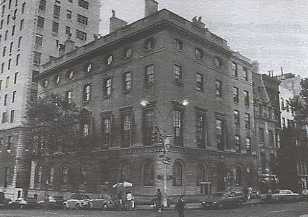The Council of Foreign Relations (CFR) began as a series of meetings organized by Colonel Edward Mandell House. In New York in 1917, President Wilson assembled about 100 elite men to discuss a peace settlement and post-war plans. These meetings produced most of Wilson’s 14 points, which he submitted to Congress in January, 1918. Wilson’s 14 points proposed the removal of economic barriers between nations, free trade, and the formation of a general association of nations (the League of Nations).
Although Wilson’s peace plans were rejected by the United States Senate, Colonel House and the British and American peace conference delegates met again in Paris in May, 1919 and agreed to form an Institute of International Affairs. The British branch of the group is the Royal Institute of International Affairs, the United States branch began on July 21, 1921 as the Council on Foreign Relations.

The Harold Pratt House in New York City is the CFR headquarters and has lavishly housed the New York liberal elite since it was donated in 1945 by the Pratt family of Rockefeller’s Standard Oil. There were originally about 1,600 members but this has grown to 3,300+ as influential figures in finance, politics, communications and academics have swelled its ranks after careful selection and rigorous screening.
Original CFR members included Elihu Root, John Foster Dulles and Christian Herter, all three of whom served as Secretary of State. John’s brother Allen Dulles was also a member and later became the director of the CIA. Nearly every one of Dulles’ successors in the CIA has been a CFR member, including George Bush and William Casey. Founding members John W. Davis and Russell Leffingwell were financier J.P. Morgan’s right-hand men, and many other early members had strong links with Morgan.

The CFR’s influence over the United States State Department began when President Truman established the Psychological Strategy Board (PSB) to coordinate psycho-political operations. It was headed by CFR members Gordon Gray and Henry Kissinger and maintained close links with the State Department and the CIA. Eisenhower changed its name to the Operations Coordination Board (OCB), and when President Kennedy abolished it, the OCB became an ad hoc committee called the Special Group, which continues today (run by CFR members). In February, 1941 the CFR gained more influence over the State Department with the establishment of the Division of Special Research, forming groups of experts to mastermind research into security, armaments, economics and politics.
CFR funding originally came from financiers including Morgan, Rockefeller and Otto Kahn, but today their funding comes from the State Department and corporations, including Xerox, General Motors, Texaco and the Rockefeller Brothers Fund. The CFR communicates its ideas through conferences, luncheons or dinner meetings. It also acts as a think tank to produce research promoting globalist ideas and agendas. The publication Foreign Affairs is their public mouthpiece. It is widely acknowledged that just as Broadway shows rise or fall on the opinion of the New York Times critic, ideas rarely make it into United States government foreign policy until they have gained approval in this CFR club magazine.
Admiral Chester Ward, a retired senior figure in the United States Navy and CFR member, co-authored a book in 1975 with Phyllis Schafly, called Kissinger on the Couch in which he states:
Once the ruling members of the CFR have decided that the United States government should adopt a particular policy, the very substantial research facilities of the CFR are put to work to develop arguments, intellectual and emotional, to support the new policy, and to confound and discredit, intellectually and politically, any opposition.
Henry Kissinger rose to prominence by exploiting his CFR connections, which included David Rockefeller. Through the CFR he gained inside knowledge of the Atomic Energy Commission, the military, the CIA, and the State Department; to write his best-selling book Nuclear Weapons and Foreign Policy, which put forth the case that a nuclear war might be winnable.
The CFR has placed its members in every presidential administration since Woodrow Wilson. Both the Republican George W. Bush and his Democrat opponent in the 2000 election, Al Gore, are CFR men. The Clinton administration included more than 100 CFR members, many of whom have become foreign ambassadors to spread the gospel of globalism.
Some critics of the CFR claim the Marshall Plan and the subsequent North Atlantic Treaty Organization (NATO) came into being after an anonymous letter published in Foreign Affairs gave Truman the nod to take a hard line against the threat of Soviet expansion.
Related Pages ¶
MP3 Files ¶
- 1967: Myron Fagan on the CFR
PDF Files ¶
- War is a Racket, Smedley Butler
- Wall Street and the Rise of Hitler, Anthony Sutton
- Wall Street and the Bolshevik Revolution, Anthony Sutton
- Wall Street and FDR, Anthony Sutton
- The Best Enemy Money Can Buy, Anthony Sutton
- The Best Democracy Money Can Buy, Anthony Sutton
- Agency of Fear: Opiates and Political Power, Edward Jay Epstein
- Treason’s Peace: German Dyes American Dupes, Howard Watson Ambruster
- The Grand Chessboard, Zbigniew Brzezinski
- Vision for 2020, United States Space Command
- 2002: America Still Unprepared, The Council on Foreign Relations
- 2003: The Bush Administration’s Contracts with Halliburton
- 2005: Building a North American Community, Council on Foreign Relations